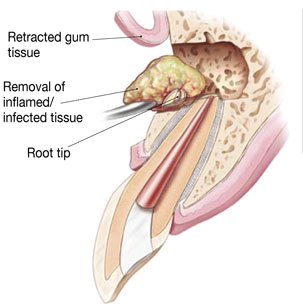

Apicoectomy, also known as root end surgery, is an endodontic surgery procedure involving the surgical removal (ectomy) of the tip of a tooth root (apex), and the sealing of the root canal. The purpose of an apicoectomy procedure is to fight an infection in the tissues surrounding the tip of the root and save the tooth from extraction. An apicoectomy is not the same as a root resection or as a hemisection. In a root resection, an entire root is removed, rather than just the tip. Apicoectomy is the most common type of root canal surgery.
Apicoectomy is a surgical procedure usually performed only after a failed root canal treatment. The majority of failed non surgical root canals are caused by problems near the tip (apex) of the root. Apicoectomy is an invasive but effective surgical procedure to overcome this kind of problems.
If the nature of the problems that caused the root canal complications indicates that a re-treatment will not be successful, an apicoectomy is the only solution. Otherwise it is advised that a root canal re-treatment by an endodontist should be attempted first. Apicoectomy is needed if an infection develops or persists after root canal treatment or re-treatment (failed root canal).
Conditions that require an apicoectomy include:
Before the procedure, the dentist will usually prescribe anti-inflammatory medication and/or antibiotics. X-rays of the problem area are needed for the dentist to plan correctly the procedure.
To improve the apicoectomy success rate, the procedure is usually performed by the endodontist or oral surgeon with the help of a microscope, which helps the dentist to achieve higher precision (for that reason it is also called endodontic microsurgery). The duration of the procedure depends on the type of tooth involved and may be from 30 to 90 minutes. Normally after a successful apicoectomy any signs of infection will disappear and the bone tissue around the root tip will heal within a few months. An infection that persists after the surgery is indicating an apicoectomy that failed.
Follow up clinical examinations and x-rays are necessary to confirm the success of an apicoectomy procedure. The apicoectomy may be the last chance for a tooth to avoid extraction, but in general the long-term prognosis for a tooth is significantly reduced when an apicoectomy is needed.
Apicoectomy success rate is high if performed by a skilled endodontist, but as in all surgery procedures there is always a risk of complications and failure. Possible apicoectomy complications are similar to those of the initial root canal treatment. In case of a failed apicoectomy, the tooth will have to be extracted.
While apicoectomies are considered as surgical procedures they cause minor discomfort. Apicoectomy recovery is usually quick and without complications. Some soreness, swelling and pain are absolutely normal after the apicoectomy surgery. Stitches are removed 2 to 7 days after the procedure, and all soreness and swelling are usually gone by 14 days after the procedure.
Some useful instructions to relieve discomfort, help healing and minimize apicoectomy recovery time are:
In most cases, the apicoectomy recovery time will not exceed two weeks. Any sign of remaining infection after this period indicates a failed apicoectomy.
The cost of an apicoectomy procedure can be significant (>1000$) depending on the position of the tooth to be treated, but it is the only way to save a tooth after a failed root canal re-treatment. Even as an alternative to root canal re-treatment, it is often quicker and more cost effective to do an apicoectomy and retrofill than to remove and replace a post, core, and crown in order to repeat the root canal treatment.
Hemisection. Hemisection refers to the removal of one-half of a two rooted tooth. The remaining half is restored as a one-rooted tooth, and is usually attached or anchored to an adjacent tooth, for additional support and stability.
Root resection or root amputation. Root resection refers to the removal of one root in a multi-rooted tooth, when there is a persistent endodontic failure in ONLY one root of an important tooth that the dentist wants to maintain.
The cost involved with apicoectomy is significant and many patients may not afford it if they are not covered by their dental insurance. Learn how to choose a dental insurance plan that will help you provide the best dental treatment to yourself and your family.
next page -> Dental Restorations